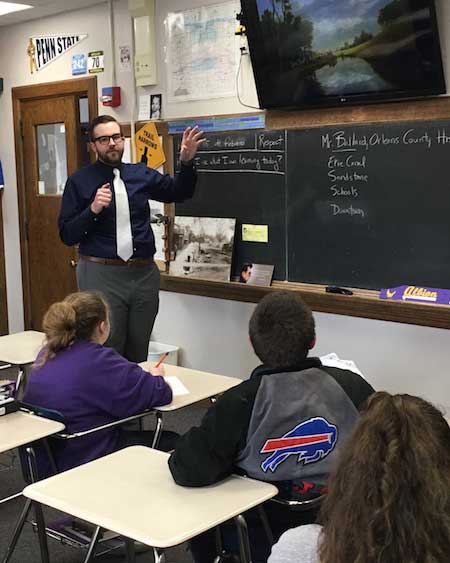Historian says many residents work to preserve local heritage

Provided photo: Orleans County Historian Matthew Ballard presents to a class of seventh grade students at Albion Middle School this week. Ballard spent two days with Tim Archer’s Service Learning classes. The historian showed old photos of canal construction, early schools, sandstone quarries, and numerous downtown sites. Ballard will be helping the students put together a 3- by 5-foot interpretive panel on how the Erie Canal developed growth and prosperity in the region. The panel is slated to be located along the canal near the fire station.
“Overlooked Orleans” – Vol. 4, No. 7
While reflecting on a topic for this weekend’s column, I started to think about some of the amazing opportunities that I have as an historian in New York. We should be thankful that the State requires the appointment of these valuable collectors and interpreters of history for any village or township with over 400 inhabitants.
The New York State Historian recently conducted a survey of county and borough historians, asking pertinent questions about how his office could better support the work of individuals like me. Responses were across the board, but made me realize that much more could and should be undertaken by the Department of History in supporting the work of our local historians.
I had the pleasure of meeting with a group of local historians this week, spending time discussing significant projects, new ideas, and upcoming celebrations. It was a chance to reflect on the hard work and dedication that each brings to the profession. We have a very dedicated group of historians who spend much of their time working behind the scenes, bringing attention to significant people and events in local history, preserving important resources for future generations, and responding to inquiries from people located throughout the world. On a side note, this past summer I had the chance to assist a gentleman from the Lorraine region of France who was researching the nasal flute, patented by William Carter of Albion.
Shelby and Barre are preparing for the passing of significant milestones as they plan for their bicentennial celebrations in the spring and summer of 2018. It is quite admirable that so much can be accomplished with the help of these dedicated individuals. More importantly, so many others in our communities stand up and join in on these endeavors as leaders and volunteers.
I spent two days at Albion Middle School speaking to around 150 seventh-grade students, sharing local photographs and talking about the impact of the Erie Canal on the development of Albion and other villages in New York. After the class, Tim Archer thanked me for taking the time to stop in and share the images and stories. I thanked him in return; no “you’re welcome” needed. I realized that opportunities to engage the youth in our community in a discussion of how local events and people shaped the world around us continue to disappear; seize those opportunities with gusto! Mr. Archer’s service learning class provides students with an ability to become active in their community from an early age, something that many will carry with them into adulthood.
I realized that it was the influence of local historians that spurred my interest in the community and therefore made the decision to remain in Orleans County after college an easy one. I know that other schools engage their students in similar ways; much more can and should be done to tap into the passionate and knowledgeable pool of historians in Orleans County.
That’s what pushed me to write on this subject this weekend; why public history? Our history teachers work diligently to inspire our children to appreciate the role that people and events have played in the development of the United States and New York. It is the realm of public history that engages us locally; the archivist, the librarian, the historian, the art curator, the museum director, all seek out ways to connect those ideas introduced in school on a more local level.
Before Christmas, I had an engaging conversation with a local resident on the role of historical study. We should consider life to be linear in which three points are required to make a straight line; the past, the present, and the future. Although we may fully understand our current point, one cannot set themselves on a straight path into the future without a thorough and complete understanding of the past. Our local historians work tirelessly to assemble an image of bygone days, sharing that with the community, and challenging the traditional narratives of history. They thoroughly scrutinize their sources, seek to produce a truthful and accurate representation of our history, and work meticulously to correct inaccuracies and false information.
As I near the conclusion of my third year as County Historian, I want to thank our village and town historians for their continued hard work and dedication to the field of history. Your commitment to writing, research, education, preservation, and advocacy is inspiring to me and your community.





































































